Scientists hope to harness the powers of quantum computers to solve unprecedented problems. Central to this goal is the ability to communicate between the quantum and classical computing worlds. To do so, they must manipulate the signals that travel both worlds to optimize their ability to read the information stored within the quantum bits inside a quantum computer.
To help meet these needs, engineers at the U.S. Department of Energy’s Fermi National Accelerator Laboratory created the Quantum Instrumentation Control Kit in 2022. QICK is a combination of a radio frequency circuit board, control and readout hardware and open-source software to control it. Today, with more than 350 registered users worldwide, the engineers created a new companion product called “QICK box,” which they are now ready to bring to market.
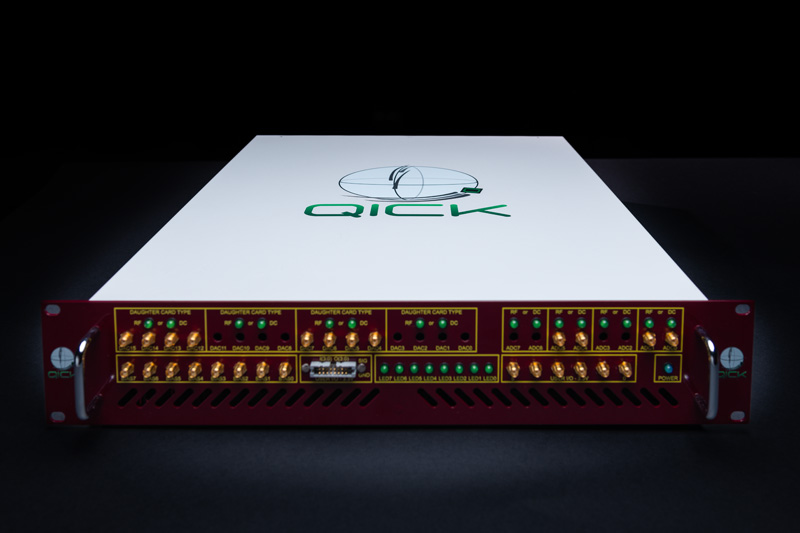
This lab-in-a-box can help scientists more easily increase signal-to-noise ratio and qubit control by strengthening the amplification and filtering of incoming and outgoing signals. QICK box includes the original QICK system based on a commercial field-programmable gate array board, or FPGA board, and adds a custom front end with all the electronics and cabling.
“Rather than having to buy a vendor board and the dozens of amplifiers, filters and other hardware needed to connect the equipment, scientists can use the QICK box, which has everything built in, is easy to use and optimized,” said Fermilab engineering physicist Sho Uemura, lead QICK software developer and a core member of the QICK development team.
Not only is the QICK box compact and cost effective, it is also flexible. Scientists can tailor the system to their needs, a bit like building a LEGO® system. They can mix and match their radio and lower frequency circuit boards, and their inputs and outputs. They can choose the number and type of additional daughter boards to buy and add them to the main board.
On the path toward an ideal readout and control system
At the heart of the QICK box is the original QICK, comprised of the FPGA, the control and readout hardware and the open-source software. QICK has ultralow noise and low latency and provides a scalable high density of output and input channels. The new custom hardware preserves these features, but also optimizes space and improves accuracy and precision. Recently, the development team rolled out QICK version 2.0 with new software and firmware, adding functionality including a brand-new core processor to improve quantum control.
Though a few companies are creating similar quantum control systems, QICK is different. The QICK team worked closely with the scientific and quantum information science (QIS) research communities to solve specific and challenging problems at their labs. The hardware used is common to many applications, but there is great flexibility in how researchers use it.
“QICK is very powerful because the field of quantum right now is changing so rapidly,” said Travis Humble, director of Oak Ridge National Laboratory’s Quantum Science Center, one of five national QIS research centers, and a primary driver of QICK’s early and ongoing development.
“I think QICK is entering that research space where we expect there to be a lot of fluctuation in the hardware design, whereas the other companies are not making the radical changes to development we know the QICK box is capable of. It’s really a different model,” said Humble.
The Fermilab team began developing QICK software and firmware in 2020 in collaboration with University of Chicago researchers. The latter aimed to create and test a controller based on a commercial FPGA board, which is often used in scientific experiments and in quantum computing experiments.
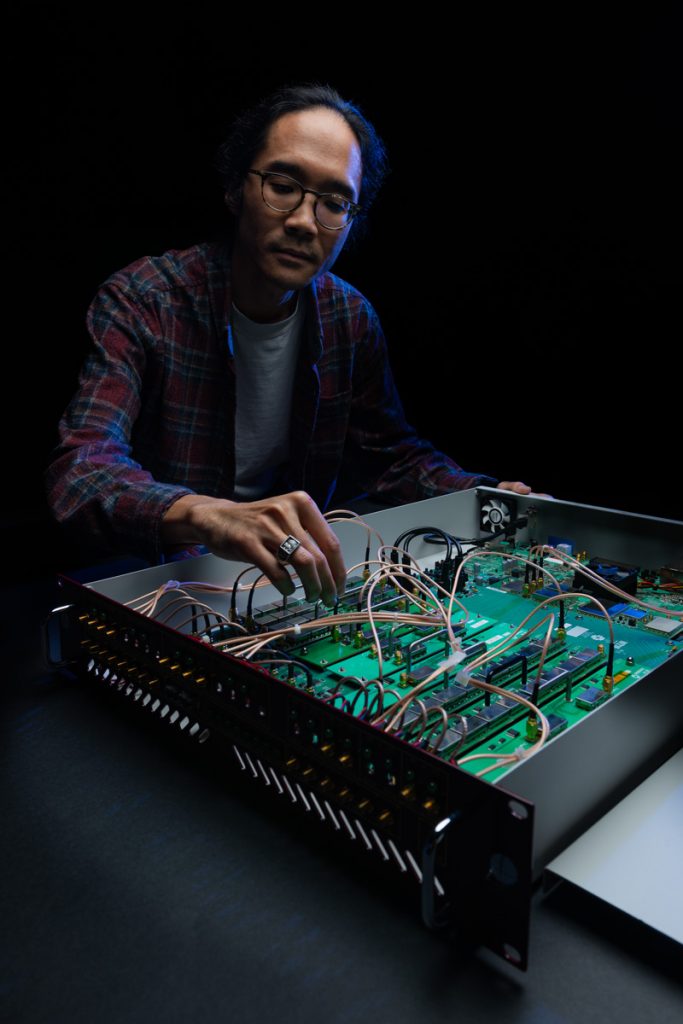
Credit: Ryan Postel, Fermilab
While cutting their teeth on designing an adaptable system over the past few years, the Fermilab team developed a close group of collaborators at institutions including Fermilab, the University of Chicago, and Stanford and Princeton Universities. These collaborators provide real-world quantum applications for QICK and present new ideas for potential functionality. They then test and debug the new features before they are added.
For example, Yale University’s Professor Michael Hatridge and his students are using QICK to explore ways to apply quantum techniques they’ve developed to help producers of larger quantum systems more readily use the technology.
“Our goal is to build a model that shows there are better ways to scale up from simple experiments we can do in the lab with a handful of qubits to larger machines. We need it to be big enough in terms of size to prove our techniques work and unique enough in operation to point to some new ways of thinking how to build quantum computers,” said Hatridge.
“We’re using QICK to be a really high-performance, inexpensive platform that we can add to as needed and to push forward control electronics capabilities for more complicated experiments,” Hatridge added.
Thinking outside the box
Fermilab engineer Gustavo Cancelo, who leads the QICK development and commercialization teams, spent most of the last three-plus decades designing electronics for experiments, not individual users. In such cases, he explains, the experiment is the only customer, and it sets the specifications at the very beginning of the design process. With QICK, it’s different.

“We are trying to commercialize a product for users that develop new ideas every day. When you design a car or a TV, you want most people to use it and like it,” said Cancelo. “So, with QICK, we try hard to think ahead and put in functionality we think users will need in the future. Quantum devices are a moving target. Every new user will bring new ideas for qubits that don’t exist yet.”
In just four years, QICK has evolved from a system used by a few scientists for one specific purpose to one used by hundreds worldwide for a variety of applications. With the addition of the customizable QICK box, the engineering team and its supporters and collaborators believe that it will enable future discoveries in science and quantum information science research.
Companies interested in commercializing the technology should contact Fermilab’s Office of Partnerships and Technology Transfer at optt@fnal.gov. The development of QICK at Fermilab is supported primarily through the lab’s key partnership in the Quantum Science Center, a DOE National Quantum Initiative Science Research Center headquartered at Oak Ridge National Laboratory.
Fermi National Accelerator Laboratory is America’s premier national laboratory for particle physics and accelerator research. A U.S. Department of Energy Office of Science laboratory, Fermilab is located near Chicago, Illinois, and operated under contract by the Fermi Research Alliance LLC, a joint partnership between the University of Chicago and the Universities Research Association, Inc. Visit Fermilab’s website and follow us on X/Twitter at @Fermilab.
Fermi National Accelerator Laboratory earned national recognition in 2024 for its sustainability efforts, receiving three notable awards from the U.S. Department of Energy. The laboratory was honored with the Outstanding Net-Zero Building Program/Project Award, a High Performance Sustainable Building Award and a Green Fleet Award. These distinctions highlight Fermilab’s ongoing commitment to reduce the environmental footprint of its operations while efficiently utilizing the resources needed to conduct cutting-edge particle physics research.
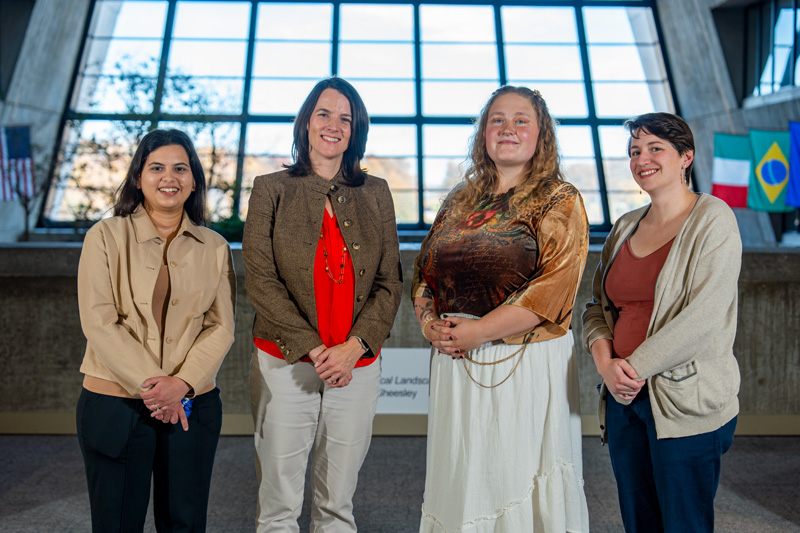
Sustainable building awards
Outstanding Net-Zero Building Program/Project Award
Fermilab’s Integrated Engineering Research Center, located next to iconic Wilson Hall, has been recognized in the 2024 U.S. Department of Energy Sustainability Awards in the Outstanding Sustainability Program/Project category. This award celebrates the IERC’s eco-friendly design, which incorporates numerous features to achieve reductions in greenhouse gas emissions, waste and pollution, and increase water efficiency.
Funded by the Science Laboratory Infrastructure program in the DOE Office of Science, the IERC includes a 20,000-square-foot green roof, large windows that maximize natural light and structural overhangs that minimize direct sunlight. These features, along with use of sustainable construction materials, contribute to significant resource savings.
The building was cited in the award for saving 500,000 gallons of water annually — enough to fill around 46 average-sized swimming pools. It was also cited for annual savings of 3.7 billion BTUs (a standardized unit of heat) through its energy efficiency and reducing vehicular travel by 354,000 miles by creating space for employees to work within walking distance of offices at Wilson Hall.
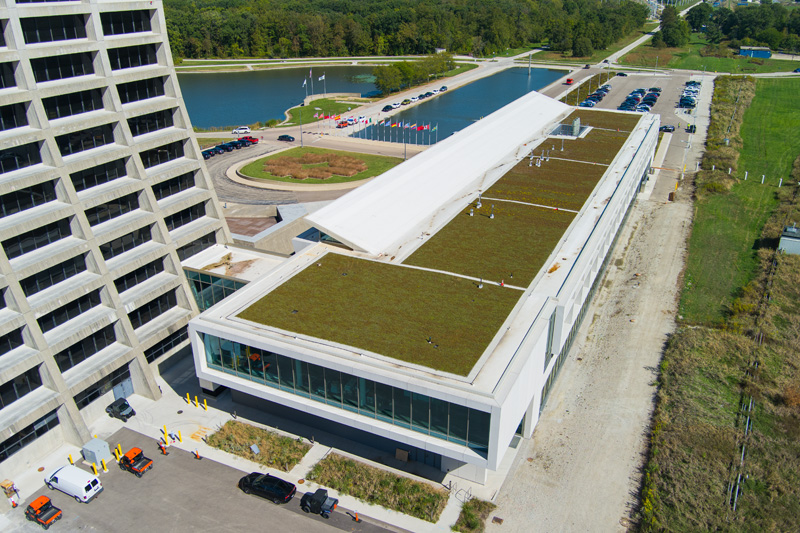
“The Integrated Engineering Research Center exemplifies Fermilab’s commitment to sustainability by not just providing a space for next-generation science experiments to be designed and constructed, but also using best practices in sustainability for the building’s design,” said Catherine Hurley, Fermilab’s sustainability manager.
High Performance Sustainable Building Award
Because the Integrated Engineering Research Center was constructed under the Guiding Principles for Federal Sustainable Buildings, it was also recognized by the DOE through a High Performance Sustainable Building award.
The Guiding Principles for Federal Sustainable Buildings provide a standardized framework for federal agencies to design, construct and operate buildings in a sustainable manner — leading to improved energy efficiency, water conservation, enhanced indoor air quality and cost-savings.
Fermilab incorporated the guiding principles in early stages of the IERC project through design elements that reduce the needs for artificial light and heating.
Materials for the project were selected to prioritize waste minimization, recycling and environmentally friendly products such as recycled, biobased and safer alternative building materials.
The IERC also incorporated building systems that could mitigate vulnerabilities and recover from the impacts of climate change. These impacts include weather events that are becoming more severe or unpredictable. For instance, the building’s green roof helps absorb rainwater.
Green Fleet Award
Fermilab also received a Green Fleet Award, recognizing the lab’s outstanding leadership in helping the Department of Energy achieve the federal goal of transitioning DOE site fleets to 100% zero emission vehicles by 2035, with 100% of light-duty vehicle acquisitions to be completed by 2027.
Jennifer Thorson, Fermilab’s fleet manager, and Catherine Hurley, manager for sustainability, spearheaded this initiative. This plan outlines a phased approach to replacing internal combustion engine vehicles with electric vehicles. The transition is well underway. In 2024 Fermilab replaced 32% of the laboratory’s 201-vehicle fleet.
“The idea is to phase out internal combustion engines completely,” said Hurley. “Internal combustion engines produce emissions that trap heat into our atmosphere and contribute to global warming.”
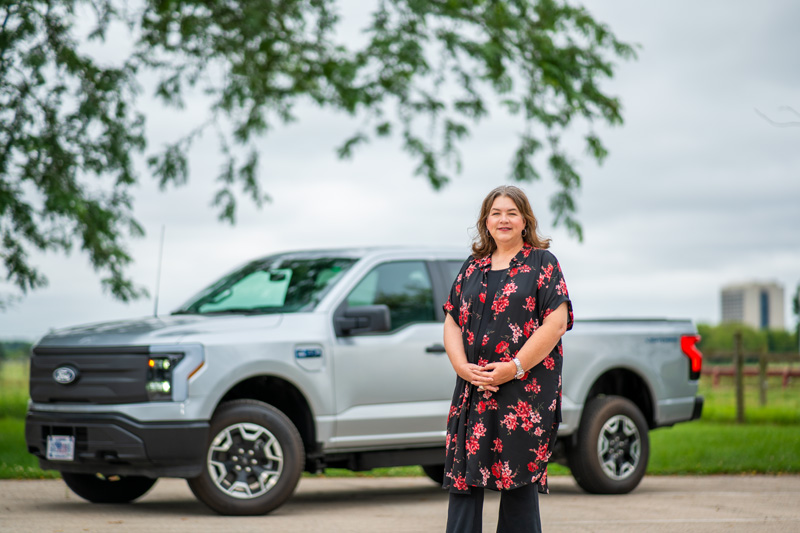
This Green Fleet Award also brings $250,000 in funding to Fermilab to install vehicle charging stations and provide for the future acquisition of additional zero emission vehicles.
These new vehicles aren’t just environmentally friendly, they also deliver impressive performance.
“After driving an electric truck, my only complaint is that I don’t have my own,” said David Butler, an operations manager at Fermilab. “The efficiency of it is ten-fold compared to my carbon-emitting truck. I’m now getting the equivalent of 132 miles per gallon.”
The staff who regularly drive vehicles at Fermilab were able to provide input for the selection of new electric models. Their feedback was crucial in selecting the zero emission vehicle models that best support their work and bring Fermilab closer to a fully electric fleet.
Each of these award-winning efforts are part of a broad strategy at Fermilab that creates a win-win scenario — increasing operating efficiency and at the same time improving the environment.
“Fermilab’s commitment to sustainability extends beyond these three awards,” said Hurley. “The lab is actively engaged in a variety of initiatives to reduce its environmental impact and create a more sustainable future for scientific research.”
Fermi National Accelerator Laboratory is supported by the Office of Science of the U.S. Department of Energy. The Office of Science is the single largest supporter of basic research in the physical sciences in the United States and is working to address some of the most pressing challenges of our time. For more information, please visit science.energy.gov.
Fermilab editor’s note: This press release was originally posted by Lawrence Berkeley National Laboratory.
The U.S. Department of Energy’s Fermi National Accelerator Laboratory contributed key elements to the Dark Energy Spectroscopic Instrument (DESI), including the online databases used for data acquisition and the software that ensures that each of the 5,000 robotic positioners are precisely pointing to their celestial targets to within a tenth of the width of a human hair. Fermilab also contributed the corrector barrel, hexapod and cage. The corrector barrel holds DESI’s six large lenses in precise alignment. The hexapod, designed and built with partners in Italy, focuses the DESI images by moving the barrel-lens system. Both the barrel and hexapod are housed in the cage, which provides the attachment to the telescope structure. In addition, Fermilab carried out the testing and packaging of DESI’s charge-coupled devices, or CCDs. The CCDs convert the light passing through the lenses from distant galaxies into digital information that can then be analyzed by the collaboration.
“These results are very exciting and show the immense power of the DESI data,” said Liz Buckley-Geer, Fermilab scientist and one of the DESI lead observers responsible for the collection of the data. “I am looking forward to helping to acquire even more data as we continue the survey.”
Key takeaways:
- A complex analysis of DESI’s first year of data provides one of the most stringent tests yet of general relativity and how gravity behaves at cosmic scales
- Looking at galaxies and how they cluster across time reveals the growth of cosmic structure, which lets DESI test theories of modified gravity – an alternative explanation for our universe’s accelerating expansion
- DESI researchers found that the way galaxies cluster is consistent with our standard model of gravity and the predictions from Einstein’s theory of general relativity
Gravity has shaped our cosmos. Its attractive influence turned tiny differences in the amount of matter present in the early universe into the sprawling strands of galaxies we see today. A new study using data from the Dark Energy Spectroscopic Instrument (DESI) has traced how this cosmic structure grew over the past 11 billion years, providing the most precise test to date of gravity at very large scales.

DESI is an international collaboration of more than 900 researchers from over 70 institutions around the world and is managed by the Department of Energy’s Lawrence Berkeley National Laboratory (Berkeley Lab). In their new study, DESI researchers found that gravity behaves as predicted by Einstein’s theory of general relativity. The result validates our leading model of the universe and limits possible theories of modified gravity, which have been proposed as alternative ways to explain unexpected observations – including the accelerating expansion of our universe that is typically attributed to dark energy.
“General relativity has been very well tested at the scale of solar systems, but we also needed to test that our assumption works at much larger scales,” said Pauline Zarrouk, a cosmologist at the French National Center for Scientific Research (CNRS) working at the Laboratory of Nuclear and High-Energy Physics (LPNHE), who co-led the new analysis. “Studying the rate at which galaxies formed lets us directly test our theories and, so far, we’re lining up with what general relativity predicts at cosmological scales.”
The study also provided new upper limits on the mass of neutrinos, the only fundamental particles whose masses have not yet been precisely measured. Previous neutrino experiments found that the sum of the masses of the three types of neutrinos should be at least 0.059 eV/c2. (For comparison, an electron has a mass of about 511,000 eV/c2.) DESI’s results indicate that the sum should be less than 0.071 eV/c2, leaving a narrow window for neutrino masses.
The DESI collaboration shared their results in several papers posted to the online repository arXiv today. The complex analysis used nearly 6 million galaxies and quasars and lets researchers see up to 11 billion years into the past. With just one year of data, DESI has made the most precise overall measurement of the growth of structure, surpassing previous efforts that took decades to make.
Today’s results provide an extended analysis of DESI’s first year of data, which in April made the largest 3D map of our universe to date and revealed hints that dark energy might be evolving over time. The April results looked at a particular feature of how galaxies cluster known as baryon acoustic oscillations (BAO). The new analysis, called a “full-shape analysis,” broadens the scope to extract more information from the data, measuring how galaxies and matter are distributed on different scales throughout space. The study required months of additional work and cross-checks. Like the previous study, it used a technique to hide the result from the scientists until the end, mitigating any unconscious bias.
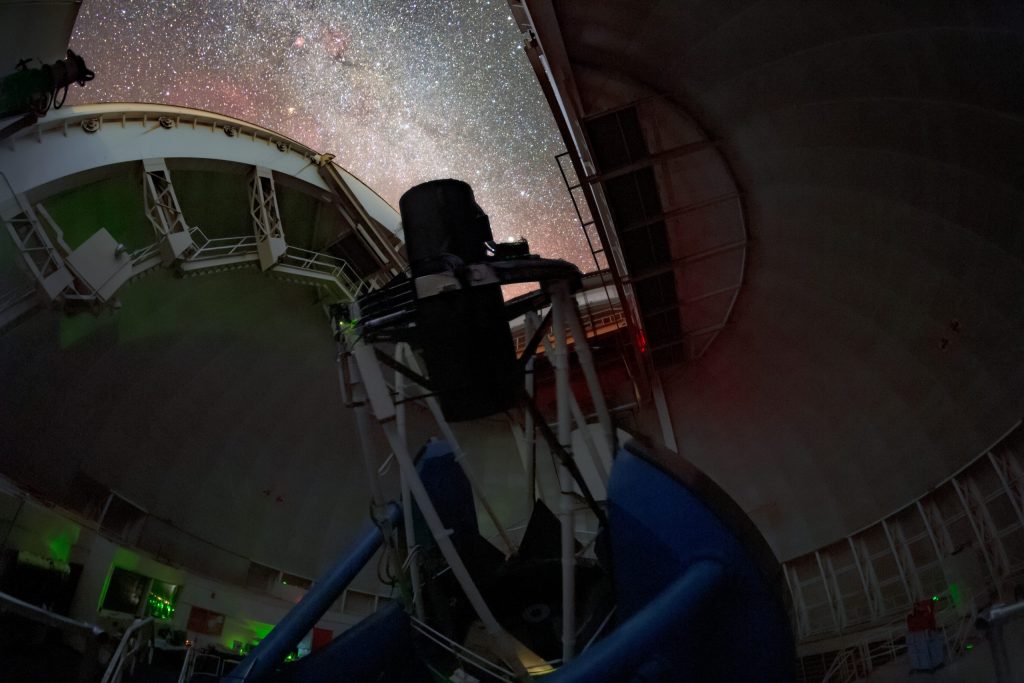
“Both our BAO results and the full-shape analysis are spectacular,” said Dragan Huterer, professor at the University of Michigan and co-lead of DESI’s group interpreting the cosmological data. “This is the first time that DESI has looked at the growth of cosmic structure. We’re showing a tremendous new ability to probe modified gravity and improve constraints on models of dark energy. And it’s only the tip of the iceberg.”
DESI is a state-of-the-art instrument that can capture light from 5,000 galaxies simultaneously. It was constructed and is operated with funding from the DOE Office of Science. DESI sits atop the U.S. National Science Foundation’s Nicholas U. Mayall 4-meter Telescope at Kitt Peak National Observatory (a program of NSF’s NOIRLab). The experiment is now in its fourth of five years surveying the sky and plans to collect roughly 40 million galaxies and quasars by the time the project ends.
The collaboration is currently analyzing the first three years of collected data and expects to present updated measurements of dark energy and the expansion history of our universe in spring 2025. DESI’s expanded results released today are consistent with the experiment’s earlier preference for an evolving dark energy, adding to the anticipation of the upcoming analysis.
“Dark matter makes up about a quarter of the universe, and dark energy makes up another 70 percent, and we don’t really know what either one is,” said Mark Maus, a PhD student at Berkeley Lab and UC Berkeley who worked on theory and validation modeling pipelines for the new analysis. “The idea that we can take pictures of the universe and tackle these big, fundamental questions is mind-blowing.”
DESI is supported by the DOE Office of Science and by the National Energy Research Scientific Computing Center, a DOE Office of Science user facility. Additional support for DESI is provided by the U.S. National Science Foundation; the Science and Technology Facilities Council of the United Kingdom; the Gordon and Betty Moore Foundation; the Heising-Simons Foundation; the French Alternative Energies and Atomic Energy Commission (CEA); the National Council of Humanities, Sciences, and Technologies of Mexico; the Ministry of Science and Innovation of Spain; and by the DESI member institutions.
The DESI collaboration is honored to be permitted to conduct scientific research on I’oligam Du’ag (Kitt Peak), a mountain with particular significance to the Tohono O’odham Nation.
Lawrence Berkeley National Laboratory (Berkeley Lab) is committed to delivering solutions for humankind through research in clean energy, a healthy planet, and discovery science. Founded in 1931 on the belief that the biggest problems are best addressed by teams, Berkeley Lab and its scientists have been recognized with 16 Nobel Prizes. Researchers from around the world rely on the lab’s world-class scientific facilities for their own pioneering research. Berkeley Lab is a multiprogram national laboratory managed by the University of California for the U.S. Department of Energy’s Office of Science.
DOE’s Office of Science is the single largest supporter of basic research in the physical sciences in the United States, and is working to address some of the most pressing challenges of our time. For more information, please visit energy.gov/science.
